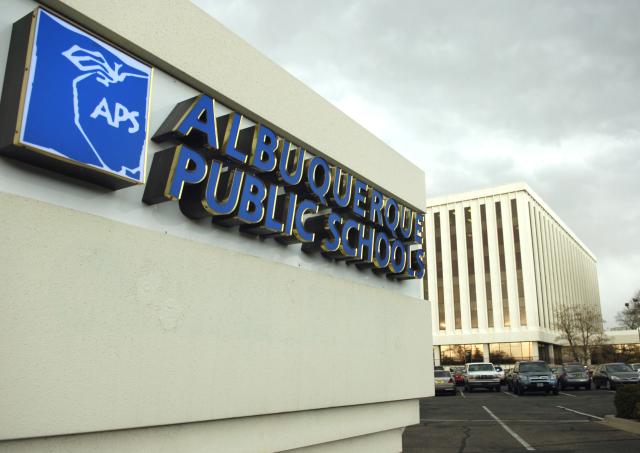The Albuquerque Public Schools board has made some big promises for its students.
Making more students proficient in early literacy and math, as well as better preparing them for life after high school are among the top priorities the school board voted 6-0 to approve last week. Vice President Peggy Muller-Aragón was absent for the vote.
The goals, board President Yolanda Montoya-Cordova said, lay out a five-year roadmap for the district that will be passed onto future boards.
“(It’s) holding ourselves accountable,” she said. “It’s like creating that North Star of where we want to go … we’re going to be successful, I think, the more focused we can be.”
Montoya-Cordova said the goals will help inform things like budget planning and strategies for district administration.
Superintendent Scott Elder said during the meeting that his administration’s next steps include coming up with a plan and initiatives that align with the board’s goals, and to gather feedback from teachers, staff and families.
The new goals were a culmination of several community listening sessions the board held throughout the city toward the end of 2022. In all, more than 2,000 people spoke their mind about what they want to see out of the district.
When asked what their priorities are for what their students should know or be able to do during their time in the district, the top three answers from community members emphasized English language arts, being ready for life after high school and soft skills — confidence, time management and the like.
The three goals approved Wednesday center on improving APS eighth-graders’ math and third-graders’ reading proficiency levels, as well as the college or career readiness of graduates.
Still, they don’t include specific percentage-point increases, instead leaving placeholders for those numbers. Board members plan to wait for 2023 test scores in order to hammer that out for the proficiency goals, but noted in them that rates must increase by at least 10 percentage points over five years.
The third goal also promises improvements — particularly in the percentage of graduates earning credit in at least two Advanced Placement or dual-credit courses, bilingual seals, industry certifications or something else — but doesn’t specify percentage-point increases.
The proficiency goals single out African American students as well as those identified in the Yazzie-Martinez consolidated lawsuit, which in 2018 yielded a decision from a judge that four groups — Indigenous, economically disadvantaged, English learners and students with disabilities — weren’t being provided an adequate education system by the state of New Mexico.
Those groups, along with Black students, make up the majority of all APS pupils.
“If we lift those boats, all boats get lifted,” Montoya-Cordova said.
Tailoring those goals toward Yazzie-Martinez students drew some resistance from a couple of board members, including Muller-Aragón — who, during a separate 6½-hour meeting on Jan. 11, got up and left when it appeared the board was leaning toward including that language.
“I am vehemently opposed to that, and if that happens, I am just saying I’m going to get up and I’m going to walk out,” she warned about 15 minutes before leaving the meeting. “We’re here for all of our kids, (it) doesn’t matter what color they are or how poor they are, or how rich they are.”
“The numbers don’t show that, Peggy,” board member Josefina Domínguez interjected.
Across the state and in APS, Indigenous, Hispanic and Black students fared the worst of any demographic group in standardized state test results released in the fall. Overall, economically disadvantaged students — who, alongside Hispanic students, each made up the majority of New Mexico and APS pupils — were in a similar boat when it came to proficiency levels.
Additionally, statewide and in APS, third-graders overall tend to perform poorly in reading, as do eighth-graders in math.
APS test results mirror state’s – except for a few key areas
Some Yazzie-Martinez students fared worse in APS than across NM…
Board members celebrated the approval of the goals on Wednesday. Still, there’s more work to do.
Many community members also mentioned a need to develop students’ soft skills — a topic the board seems poised to tackle with another goal this coming Wednesday.
“That was maybe the No. 1 thing … you know, that grit, resilience, timeliness, stick-to-itiveness. All of that stuff, that’s what people want,” board member Danielle Gonzales said. “School climate is huge — social-emotional learning, soft skills … So I am worried that if we don’t do that, then we won’t meet those other goals.”
APS board’s goals
These are the goals the board approved, as provided by Albuquerque Public Schools. The X’s and Y’s are placeholders to be determined later. The first two metrics are “to be determined upon receipt of 2023 results from the state assessment but shall not be less than a 10-point increase over five years.”
- EARLY LITERACY PROFICIENCY: The percentage of third-grade students from student groups named in the Yazzie-Martinez joint settlement plus African American students who demonstrate grade level proficiency or above on the state English Language Arts (ELA) summative assessment will increase from X in May 2023 to Y in May 2028.
- MATHEMATICS PROFICIENCY: The percentage of eighth-grade students from groups named in the Yazzie-Martinez joint settlement plus African American students who demonstrate grade level proficiency or above on the state mathematics summative assessment will increase from X in May 2023 to Y in May 2028.
- POST-SECONDARY READINESS: The percentage of high school graduates who earn credit in two or more Advanced Placement, International Baccalaureate, or Dual Credit courses, or earn an industry certification or Bilingual Seal, will increase from X in September 2023 to Y in September 2028.



